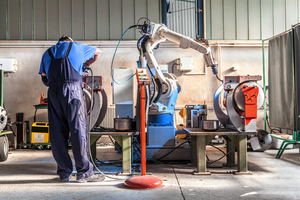 What will the factory floor of the future look like? Will it resemble the famous ‘lights out’ Foxconn plant in Shenzhen, delivering levels of automation that can make human beings all but obsolete? What’s the reality behind the hype? And how will the new realities of the post-Covid world affect it?
What will the factory floor of the future look like? Will it resemble the famous ‘lights out’ Foxconn plant in Shenzhen, delivering levels of automation that can make human beings all but obsolete? What’s the reality behind the hype? And how will the new realities of the post-Covid world affect it?
Industry 4.0 - there’s no going back
Many parts of the manufacturing sector have been hit hard by the economic shut down of the last few months. But one thing is for sure - even in the face of Covid (and now Brexit), the seismic influence on the sector of Industry 4.0 can’t and won’t be reversed. In fact, for those who survive the current crisis, these two realities are likely to drive further investment in this technology rather than halting it.
The power of IoT, 3D-printing, robotics, sensors, cloud computing and AI will all continue to be harnessed to increase automation and find new efficiencies for businesses in a hypercompetitive world.
Highly adaptable robotics will increase the range of tasks that can be automated, and they will be able to switch more quickly between those tasks - speeding up production and the potential for more customisation.
Further advances in remote access and machine learning tech, powered by ‘big data’ will mean errors and inefficiencies in robotic production lines can be corrected and optimised on the fly.
This will maximise uptime for factory production lines, as well as the volume and quality of items capable of being produced.
Are Smart Factories the answer?
In some regions the ultimate dream of the ‘smart factory’ has apparently been realised; an answer to an unpredictable future of rising labour costs and shifting customer demands. The Foxconn plant in China has been trailed as a facility connected by 5G and wireless technology - fed by data from deep within the supply chain. At Foxconn, machines calibrate themselves and continually regulate their own performance with little or no human intervention on the factory floor. The ‘lights are out’ in these automated factories because their robot inhabitants simply don’t need them - making them greener and more cost-effective at the same time.
A dawning reality
But the experience in Shenzhen has reportedly been mixed. Not only have changes in global demand following Coronavirus exposed problems with reliance on international supply networks, but automation has proved impossible for many of the tasks that their client, Apple needed them to achieve:
“The results found that robots struggled with delicate tasks such as placing iPhone screws and applying glue.”
It appears, there are some things that machines just can’t do. And as Elon Musk tweeted, about his own company’s excessive use of automation - ‘humans are underrated’.
Imagining a different future - enter Industry 5.0
For some, the promise of Industry 5.0 is a more realistic and exciting vision of the future.
Whereas Industry 4.0 put smart technology at the forefront of manufacturing, 5.0 is imagining increased collaboration between humans and smart systems. Combining the two, they say, will merge the speed and accuracy of industrial automation with the cognitive, critical thinking skills of humans.
Cobots not Robots
Through increased use of technology such as VR headsets, tablets and smartwatches, humans will be able to collaborate more deeply and safely with machines. In fact, this kind of approach is already delivering powerful results for some manufacturers as they face the greater customization and servitization challenges of the modern world. Toronto’s Paradigm Electronics, for example, found that efficient production of their high-end speakers could be increased by 50% simply by adding a human counterpart to a robotic process.
Where will the factory floor be located in the future?
Of course, it’s not only a question of what the future factory will look like but where it will be located for maximum efficiency and resilience.
Covid-19 has shown that a global manufacturing network can leave businesses vulnerable in significant ways. What happens when an international supply chain is disrupted as it has been in recent months? What happens when we can’t access the parts and components we need from far away distributors? What happens if borders shut down and the costs of accessing services rise? If the costs of production are rising in places like China, much of the argument for off-shoring is being lost. ‘Reshoring’ is a trend that may protect markets from a more unpredictable future of international supply and demand.
Predicting the future is a tricky business
But one thing that is becoming obvious from all of this is that the most successful factory floors of the future will be those that are the most responsive and agile.
Covid-19 has led to inspirational stories of agile thinking emerging from the manufacturing sector. From alcohol production lines being turned over to producing hand sanitiser, to the likes of Dyson and McLaren switching their precision engineering skills to produce medical ventilators for the NHS. These companies had the ability to transfer complex technical specs to state-of-the-art production facilities with minimum disruption.
To survive in an unpredictable future every manufacturer may need access to this kind of technology, as well as the imagination to be ready for anything.
Agility is everything
The future will undoubtedly mean more and smarter technology delivering better value and more customised products to the marketplace. These products will likely need to be delivered on-demand and more quickly than ever before, through smart, collaboration between humans and computers.
For many companies, there will be opportunities for new ventures, but maybe in unfamiliar sectors with unfamiliar manufacturing requirements. To feed this kind of innovation there may need to be more outsourcing and more reshoring - driven by more agile, cost-effective and scalable manufacturing partnerships.

